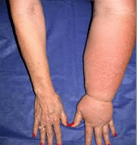Lymphedema is the result of a defect in the lymphatic system. The lymphatic system is made up of lymphatic channels, lymph nodes and lymphatic ducts. It is a uni-directional transport system that functions to maintain fluid balance in the body through the transportation of fluids, as well as filtering and removal of waste products. It also aids the immune system.
 Lymphedema is the abnormal accumulation of protein-enriched fluid (lymph fluid) which appears as swelling in an extremity. There are two types of lymphedema. Primary lymphedema is a genetic defect of the lymphatic system. Secondary lymphedema is more common and is caused by insufficiency or damage to the lymphatic system, usually following surgery or radiation to areas of lymph nodes. This swelling can lead to hardening of the underlying tissue and skin (fibrosis) and also increases the risk for infection (cellulitis).
Lymphedema is the abnormal accumulation of protein-enriched fluid (lymph fluid) which appears as swelling in an extremity. There are two types of lymphedema. Primary lymphedema is a genetic defect of the lymphatic system. Secondary lymphedema is more common and is caused by insufficiency or damage to the lymphatic system, usually following surgery or radiation to areas of lymph nodes. This swelling can lead to hardening of the underlying tissue and skin (fibrosis) and also increases the risk for infection (cellulitis).
What are the symptoms of lymphedema?
Initial symptoms of lymphedema are a feeling of heaviness, achiness or tightness of the arm, hand, leg or foot, or the inability to wear rings, watches or clothing due to discomfort or tightness. Often times, there is not visible swelling in the extremity initially. As the lymphedema progresses, visible swelling will occur. As it continues to progress, the tissue will thicken or harden.
Who is at risk?
Anyone who has had radiation therapy or surgery to remove lymph nodes is most at risk, because the lymphatic system has been compromised. Studies show up to 33% of patients who have had surgery for breast cancer will develop lymphedema at some point. Lymphedema can occur immediately after surgery, or not occur until years later.
How is lymphedema treated? Can it be cured?
There is no cure for lymphedema at this time. Lymphedema is a progressive disease that will worsen if left untreated. The key to managing lymphedema is early identification and treatment such as Lymphedema physical therapy, there is more on that below. The earlier lymphedema is diagnosed and treated, the better the outcomes are. At Elite, we have Physical Therapists (PT) who specialize in lymphedema treatment and management. Initial treatment involves education about caring for the involved extremity and the importance of compliance to the program. The next step is to decrease the swelling using manual techniques and compression bandaging. Ultimately, the patient is fitted with a compression garment (sleeve or stocking) to wear. Compression is the key to maintaining the lymphedema extremity. Proper care of the extremity and wearing the compression garment will achieve this.
If you have undiagnosed swelling in an extremity or would like more information, contact your physician or Physical Therapist for treatment options.


